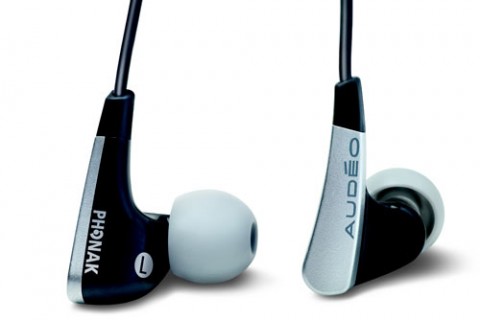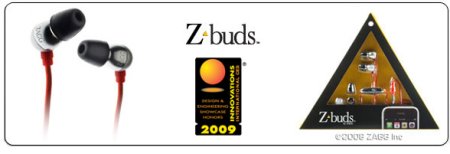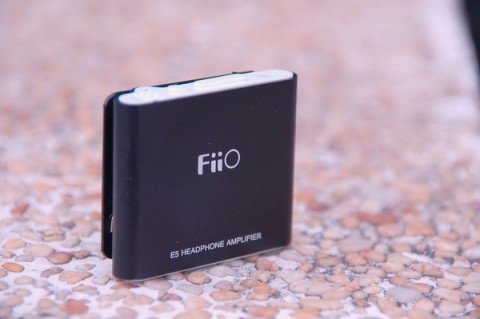 By: Martin Sägmüller on October 16, 2008 12:23 AM
By: Martin Sägmüller on October 16, 2008 12:23 AMHere they are, the Ultimate Ears UE 11 Pro: reference ear monitors worshipped by recording artists, sound engineers, and audio nuts alike.
Besides the EarSonics EM3 and ACS T1 they're the most expensive in-ear phones available at the moment. Ahead of all others in the ear monitor race however, the UE 11 raises the ratio of drivers per earpiece to a whopping four armatures. That’s more drivers than many full-sized floor standing speakers have.
Do I notice similarities to the marketing stunts of certain shaving utensil manufacturers, adding one more blade to every new razor model? While these delusions of grandeur appear a bit nonsensical for something you waggle around your face to get rid of stubbles, let’s see how the old “more is better” applies when it comes to professional ear monitors.
- Specs
- Drivers: custom quadruple balanced armatures (2x bass, 1x mids, 1x treble), passive three-way crossover
- Sensitivity: 119dB @ 1mW
- Impedance: 18 Ohm @ 1kHz
- Frequency range: 10Hz – 16.5kHz
- Cable: 122cm or 168cm (Y-style), user replaceable, angled 3.5mm gold-plated plug
- Accessories: Engraved carrying case, storage box, cleaning tool, printed manual
Accessories
One would expect some rather upscale accessories to come with a phone like the UE 11. While you don’t get a diamond encrusted mahogany chest with them, the included aluminum carrying case is probably the next best thing. It’s about 14x17x6 cm and has the owner’s name engraved on top. In my opinion it looks really classy. It’s not exactly the equivalent of a Storm or Pelican case, but it should withstand any moderate abuse. The foam padding on the inside of the case has two pre-cut compartments – one for the smaller earphone storage box and another one that’s (not surprisingly) cut to the dimensions of an iPod. Of course it will fit other players as well; it just needs some utility knife surgery to fit a larger player.
The smaller quadratic aluminum box, measuring 7x7x3 cm, is lined with some flock/felt material. This is not a good thing. The flock fibers come loose and stick to the earphones. When I first received my UE 11, they were covered in that dust. It might become a serious issue if too many of those particles enter the sound ports.
Good thing Ultimate Ears also provides a cleaning tool for these dirt/dust issues. It has a wire loop on one end for removing gunk from the sound tubes and a very rigid brush on the other end – which purpose eludes me. Not even the manual mentions the brush. In any case, cleaning the exterior of the phones with an antiseptic wipe seems to be a better method than brushing.
On a side note, to protect the phones from moisture I use a few bags of desiccant material in the storage box. You can get these from any hearing aid specialist, probably for free. They also come with computer parts, in shoe boxes, and so on.
One accessory I’m missing with the UE 11 is a 3.5 to 6.2mm adapter. I can’t be the only person using the UE 11 with a desktop headphone amplifier sporting a 6.2mm jack; these phones are just too good to be used only on the go. Furthermore, UE’s cheaper Super.Fi and Triple.Fi series includes that adapter – it really shouldn’t add more than $1 to the cost of the phones.
Design, Build, Specs
First things first: you can’t just waltz into a store and buy the UE 11. Their housings are custom molded for your ears, requiring you to get ear impressions made by an audiologist and sending those to Ultimate Ears in California.
These impressions are scanned with a 3D scanner and stored in Ultimate Ear’s database for future reference. A negative mold is made and filled with liquid acrylic that hardens when exposed to UV light. This gives the basic shell, which then is manually processed to get rid of imperfections. The armature drivers are individually tuned to narrow tolerances and put into the housing, together with the passive crossover. Some more tweaking is done to the two sound tubes going from the drivers towards your ear drums to achieve the correct sound.
I want to thank Martin Zwettler from audiophon.at for making perfect impressions of my ears, free of charge. It can be quite a hassle getting your impressions rejected by Ultimate Ears because they don’t match their quality standards... especially for people like me, living on another continent, where flawed impressions would add several more weeks of waiting time.
Of course Ultimate Ears custom phones can be blinged out for a little extra cash with different colors, logos, or even gems. There’s an entertaining Ear Art Gallery on UE’s website showing the possibilities (and also the questionable taste of a few well known recording artists). I chose the standard silver UE logo and a translucent grey shell. A true geek doesn’t hide the inner workings of these phones.
With the cable you get some options as well. You can choose between two lengths (122/168cm, 48/66”) and five colors (beige, black, brown, clear, white). The cable sleeving is made of an excellent soft and flexible material; it doesn’t tangle as much as most other IEM cables. It is user replaceable, so damaging the cable is only a minor issue and doesn’t mean the whole phone has to be replaced or sent off for repair. Unfortunately there’s no choice when it comes to the 3.5mm plug on the cable – only an angled plug is available. If you want a straight plug you might as well start warming up your soldering iron now.
The cable’s Y-splitter is a bit of a botched design (see photo above). It really is Y-shaped and thus doesn’t play well with the small plastic tube that’s used for joining the two cables going to the earphones. Westone uses a very similar splitter on their cables, but without the pronounced Y shape – this one seems more reasonable. Other than that, the UE 11’s splitter seems to be sturdy enough and the strain relieves are of the tried-and-proven kind.
On the earphone end of the cable we find the gold plated prong connectors and the memory wire. That’s the plastic tube with a flexible wire inside, used to direct the cable up around your ears. The memory wire might be a nice feature for some people, but I don’t like it much. It’s hard to bend into a really comfortable position and it increases the transmitted cable noise for wearers of glasses. Needless to say, I removed the plastic tube and wire and enjoy my UE 11 without it. The cables stay in place perfectly fine without the wire.
The aforementioned cable noise, often referred to as “microphonics” is my biggest gripe with the UE 11. Together with bone conductivity made audible by the phones, due to their large surface contact area with the ear/skull and their hard acrylic shell, this accounts for quite a bit of unwanted noise transmission. The cable rubbing against a shirt is pretty loud, your own footsteps can be heard as bassy thuds when running (better wear soft sneakers instead of leather soles), and eating cornflakes while wearing the UE 11 can almost lead to noise-induced tinnitus. When I use the phones while working out, I even can hear my own blood pulse clear and loud in the ears. Of course there’s not much one can do with a shell construction like that. Maybe a soft silicon shell like used on Sensaphonics IEMs is less susceptible for these unwanted noises, but it seems I have to learn to accept it with the UE 11.
I have to mention that I usually listen at very low volume levels, probably much quieter than many people are used to. If I turn the volume up to levels that are uncomfortable for me (but perfectly fine for other folks, such as my girlfriend) these noise transmission issues disappear.
Besides those issues, the phones’ construction is great. They’re comfortable enough for regular use and they stay securely in one’s ears, no matter how heavy of a headbanger one might be. Granted, for my taste they’re a bit too big for use in bed, the way they fill one’s ears with hard acrylic. For me they stick out a little too far to be used comfortably while sleeping, but other people have no issues with that. Don’t get me wrong – they’re far from being uncomfortable, it’s just that they don’t “disappear” like smaller phones. Some universal-fit IEMs have an advantage there.
Isolation from outside noise is probably as good as it gets for an in-ear phone. The UE 11 block noise a bit more than the best isolating non-custom phones, like the Etymotic ER series, or the Shure SE530 with foam tips. It’s still not quite as much isolation as, say, sticking your fingers in your ears, but they block wide-range frequencies like car traffic, wind, or water very efficiently. Active noise-canceling phones don’t come close to this amount of attenuation – not to mention those need batteries and generally don’t sound as good as the UE 11.
The low impedance and high sensitivity rating of the UE 11 might suggest that they hiss with lower quality sources like portable players. I’m glad to report this isn’t the case. Sure, there’s a little background hiss with some MP3 players, but it’s almost negligible. Compared to some other hyper-efficient phones the UE 11 are very well behaved.
The armatures used in the UE 11 might come from Knowles Electronics, manufacturer of armatures for almost all IEMs and hearing aids in existence. However, they bear the UE logo, so they are most likely custom made and tuned to UE's specifications.
Amplifying the UE 11 isn’t really necessary; they work fine with most portable players. Of course an amp might squeeze even higher quality sound out of them. But in the end this last bit of quality is what it’s all about, I believe… otherwise one wouldn’t consider using phones that cost more than a thousand bucks anyway.
Sound
For me the most convenient feature about the UE 11’s sound is that it takes the guesswork out of which phone to choose for certain kinds of music or listening situations. Until now I used to pick a specific IEM for certain tasks, like critical listening/monitoring contrary to enjoying laid-back muzak, I had to choose if I prefer a lot of bass at the cost of reduced precision or vice versa, I had to keep in mind that some IEMs don’t work well with very dense orchestral pieces, and so on. With the UE 11 it’s easy – they work well with any audio material you throw at them, with hardly any compromises. A drawback would be that the rest of my earphone collection started gathering quite a bit of dust.
The bass response is very fine, both in quality and quantity. Speaking in relative terms, I would say we’re dealing here with the performance of a precisely tuned Velodyne or Hsu subwoofer, reducing many other IEMs’ bass performance to the equivalent of a cheap boomy car sub. The UE 11’s bass attacks fast, it is punchy and textured – everything you expect from a quality low frequency reproduction.
I’ve noticed some reviewers complaining about the UE 11 having too much bass. I definitely cannot agree with these opinions. The UE 11’s frequency response reminds me of full sized speakers, not some tiny bookshelf monitors. People who believe that a perfectly flat bass response means a “true to the source” or “faithful” sound reproduction should look up the definition of “Fletcher-Munson equal-loudness contour”, or the ISO 226:2003 standard. The human hearing doesn’t interpret a completely flat response as such; the bass needs to be slightly elevated to be perceived at natural sound pressure levels. The UE 11’s bass response is certainly closer to the dubious audiophile ideal of “how the artist meant the recording to be heard”, than many other phones with less bass. The UE 11 aren’t basshead cans, but they have real bass – bass that goes down to 20Hz without breaking a sweat and without making the rest of the frequency range muddy. It can’t get much better than that.
The midrange is a bit on the “dry”, analytical side. They don’t have the lush silky tonality of, say, a Sennheiser HD650 driven by a tube amp. Here it’s most apparent that the UE 11 were designed as professional ear monitors and not as regular Hi-Fi phones with tendencies to color the sound in an euphonic way. This isn’t a bad thing – it’s just that the old “crap in, crap out” rule applies: with badly mixed/mastered recordings you will notice the inferior sound quality; the UE won’t sugar-coat it. On the other hand, with well produced tracks you will hear the proverbial angels singing – every detail, every nuance delivered in all their glory. No matter if voices, acoustic or electrical instruments, jazz trios, orchestras, metal bands, drum’n’bass acts, or anything in between. For me this is a more welcome approach to sound reproduction than compromising audio quality for the sake of “polishing” muddy or hot-mastered material to become more or less listenable. Excellent clarity and dynamics is what describes the UE 11’s midrange sound best.
The UE 11’s treble is very… “fast”. A phenomenon I usually experience from phones like the q-Jays, which for me are top notch in treble reproduction. Cymbals, hi-hats, and similar material is delivered with attack speeds like on very few other phones. It sounds like the real thing on the UE 11, not like a reproduction. If you think Etymotic ER-4 or AKG K701 have proper treble, you might need to test the UE 11… Not to mention phones like the Shure SE530 or almost all “slow” dynamic driver IEMs, which don’t even come close. Admittedly, the UE 11’s treble is slightly recessed (but not rolled off). It doesn’t hit you with its full weight (like the q-Jays), but this doesn’t mean that any sonic cues are missing at all. Everything is there, every little bit of detail. It just isn’t as fatiguing as with some other phones. It even has that nice “shimmer” that I really appreciate with certain female vocals, violins, and other material. The UE 11’s treble is more or less perfect. Not to mention Ultimate Ear’s honesty of rating them up to a range of 16.5 kHz, which is perfectly fine – not the usual standard claim of a 20 kHz response or some similar half-truth.
Stereo imaging is a remarkable feature on the UE 11. It may not be the widest soundstage, defying the laws of physics by reaching a mile to the left and right of your head (the V-Moda Vibes or MylarOne X3i are slightly more expansive), but it does one thing right that most other ear monitors don’t: getting rid of the “three blob soundstage”. Music really pans smoothly between both ears, contrary to the usual crude distinction of “left-ish/middle/right-ish”. Furthermore, the UE 11 are the only IEMs I know that have a slight sense of dimensionality to the front and back, up and down. It’s even noticeable with mono recordings: some sounds are right behind your eyeballs, others are in the back of your head. This might sound unappealing in an anatomical way, but it sure is a pleasant sonic experience.
The UE 11 might not exactly have the soundstage of the AKG K701, the smooth midrange of the Sennheiser HD650, the bass impact of the Ultrasone HFI-780, or other characteristics that make quality full-sized headphones generally better than in-ear monitors. But then again, you can’t put the HD650 in your jeans pockets or use them in a noisy subway. It is an unfair comparison anyway: the UE 11 are not the exact equivalent of big cans – nevertheless they’re very close despite their comparatively tiny form factor. That’s better than it usually gets, considering most other IEMs don’t even compare to way cheaper headphones than the ones I mentioned above.
Comparing other IEMs to the UE 11 is difficult. That’s why I used these slightly far-fetched references to full-sized phones instead. All other IEMs I know – even the best – do a good job in certain aspects, but lack in other ones. Not so with the UE 11. When I listen to music with these earphones I never found myself wishing for “more”, I just enjoy the sound.
You have to hear the UE 11 to believe it. They’re seriously good.
Conclusion
Are they worth the immense price tag of $1150? In my opinion they are, especially when considering the law of diminishing returns in high-end audio. Certain other ear monitors – no matter if $50 or $500 – might be overpriced in my opinion, since they all have their fair share of flaws, but with the UE 11 I can’t find anything major to complain about. The UE 11 sound the best of all ear phones I know. If money is no object, they wouldn’t be a bad choice for almost any application. There aren't many ear monitors that deserve the commendation “reference”, but the UE 11 would be one of them.
There’s nothing specific to mention like, “aaah, the treble” or, “whoa, the bass” – since everything is just very fine with the UE 11. They sound better and isolate better than most other IEMs – cable noise and bone conductivity are an issue, but other than that I couldn’t think of any flaws. It’s kind of boring trying to describe phones that do almost everything right. Four drivers (and some quality engineering) indeed do make a difference; they’re not a marketing ploy by any means.
Well, now that I’ve listened to the UE 11 I can die happy. Don’t expect any more headphone reviews from me… or maybe you should, now more than ever.
Pros
- Excellent sound quality with hardly any flaws
- Excellent clarity, instrument separation, dynamics
- Very detailed, accurate stereo imaging
- Good noise attenuation
Cons
- Cable noise and bone conductivity could be better (at low listening levels)
- You can’t share the experience with other people.
Purchase
Your best choice is ordering them directly from Ultimate Ears. There are some resellers for Europe and other regions, but their asking price is in general considerably higher than ordering them directly from UE, so I wouldn’t recommend going that way.
Thanks to Lauren Kamm and Austin Appel for their help in making this review possible.






























 The Gadget: Moray in-ear headphones from gaming gear giant
The Gadget: Moray in-ear headphones from gaming gear giant  The Gadget: V-Moda Vibe II, the first real successor to the
The Gadget: V-Moda Vibe II, the first real successor to the 






 Griffin has announced updated versions of their TuneBuds Mobile and SmartTalk products for both versions of the iPhone, the iPod nano 4G, iPod touch 2G, and iPod classic (120 GB). TuneBuds are intended to be an alternative to Apple's upcoming
Griffin has announced updated versions of their TuneBuds Mobile and SmartTalk products for both versions of the iPhone, the iPod nano 4G, iPod touch 2G, and iPod classic (120 GB). TuneBuds are intended to be an alternative to Apple's upcoming  The Tritton AX Pro is not a bad looking wired surround sound headset that happens to be compatible with PC, Xbox 360 and PS3 audio and chatting. It features full Dolby Digital 5.1 hardware decoding, along with inline adjustments to independent front, center, rear and subwoofer channels—comprised of eight speakers in all.
The Tritton AX Pro is not a bad looking wired surround sound headset that happens to be compatible with PC, Xbox 360 and PS3 audio and chatting. It features full Dolby Digital 5.1 hardware decoding, along with inline adjustments to independent front, center, rear and subwoofer channels—comprised of eight speakers in all. Monster just announced their first ear buds, the Turbine "In-Ear Speakers", a followup to the
Monster just announced their first ear buds, the Turbine "In-Ear Speakers", a followup to the  These
These Atomic Floyd is new to the personal audio headphones game, and their first bit of kit is actually pretty decent looking. The AirJax headphones are in-ear, but have earloops made of something they're calling Titanium2 (even better than version1?). They're also made of "acoustic steel" which is apparently specially heat-treated for maxiumum audio quality, and you can rotate the in-ear part relative to the metal frame for a custom fit. The AirJax gets a UK launch first in December for $180, putting them at the luxury end of things. [
Atomic Floyd is new to the personal audio headphones game, and their first bit of kit is actually pretty decent looking. The AirJax headphones are in-ear, but have earloops made of something they're calling Titanium2 (even better than version1?). They're also made of "acoustic steel" which is apparently specially heat-treated for maxiumum audio quality, and you can rotate the in-ear part relative to the metal frame for a custom fit. The AirJax gets a UK launch first in December for $180, putting them at the luxury end of things. [




